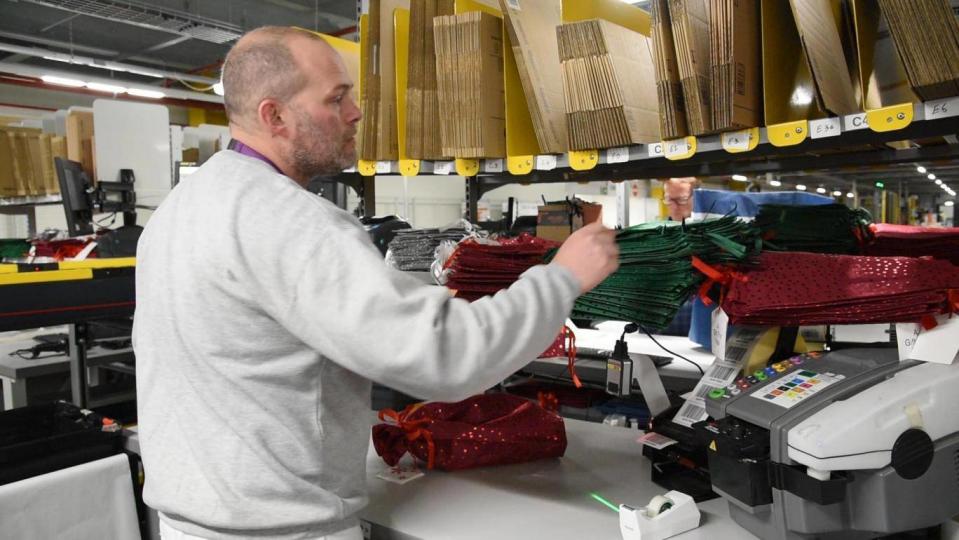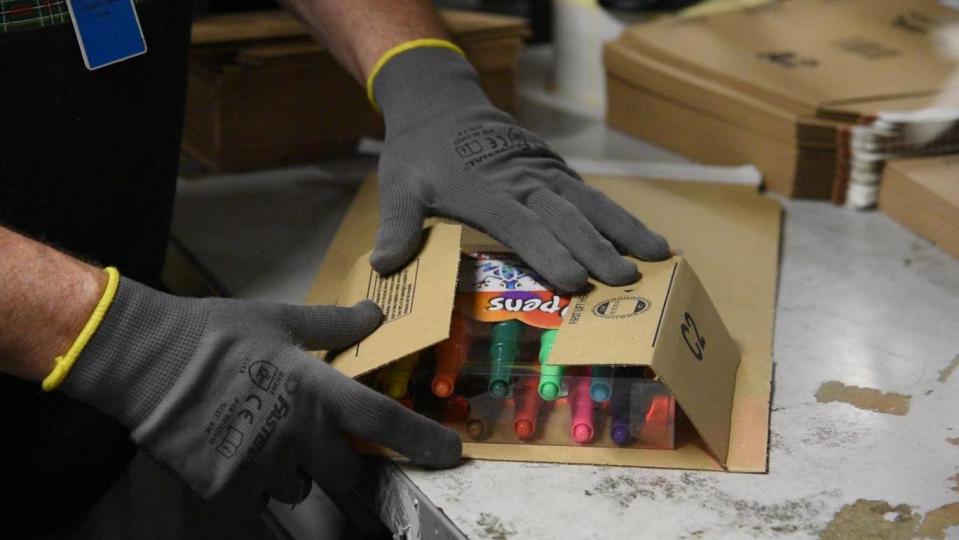Amazon at Christmas: How the online superstore packs and delivers presents and products across the UK
It’s 10:30 on a Wednesday morning just under four weeks before Christmas, and on a massive industrial site beneath the flight path of Manchester airport the atmosphere is one of concentrated calm.
Well over 2,000 workers of all backgrounds, ages, experience levels and nationalities are focusing on their sole task at hand: ensuring that tens of thousands of households around the country get all their gifts and stocking-fillers in time for the big day, wrapped and ready to be placed under the tree.
Amazon’s 16 so-called fulfilment centres scattered across the UK are where goods are shipped to sorted, packaged and then distributed around the country, around Europe and sometimes even around the world.
It’s an arduous task, and as December approaches the Seattle-based giant is forced to increases its seasonal staff count by a staggering 20,0000 across Britain. But on this Wednesday there’s no trace of panic – at least not yet.
“Just like supermarkets around the country gearing up for Christmas, we pride ourselves on being organised,” says Neil Travis, who manages the whole site in Manchester, which opened just over a year ago, making it one of Amazon’s newest.
He tells me that he started increasing staff levels well ahead of the Black Friday weekend, training temporary workers on health and safety measures, how properly to handle machinery and go about their other everyday tasks.
“It’s all in the planning,” the jovial 50-year old says, as he wanders across one of the centre’s vast floors, skirting no less than 11 kilometres of conveyors belts and countless pieces of machinery, greeting each worker as he goes, many by their name.
“I don’t know what everyone is called but I certainly try my best,” he chuckles.
Global Behemoth
Amazon – the brain child of entrepreneur Jeff Bezos – is the world’s largest internet retailer in terms of revenue and market capitalisation. In just over two decades, it has transformed from being a humble online bookshop to embodying an icon of 21st-century consumerism. It’s the sixth most valuable brand in the world, according to Forbes, and it’s diversifying rapidly.
Earlier this year it snapped up high-end supermarket chain Wholefoods for $13.4bn (£10.02bn), breaking into the bricks-and-mortar world and challenging established supermarket chains, like Walmart – just as many of those rivals struggle to gain a footing in the virtual universe that Amazon already dominates.
It’s a behemoth. 53-year old Bezos is now the world’s second richest man, trailing only financier Warren Buffet. And Christmas across many of the UK’s cities, towns, villages and even hamlets just wouldn’t be the same without Amazon.

Although the company doesn’t reveal how much revenue it generates by country, it does report that the UK is its fourth biggest international market, behind the US, Germany and Japan.
This year in the UK, electronics have been particularly popular, but over the Black Friday weekend Amazon was also pushing discounts on items as diverse as a Le Creuset casserole dish and tickets for the West End musical School of Rock.
The fulfilment centre itself processes everything from babies’ nappies to games, kitchen equipment, books, electronics and cookery utensils.
As I wander past one of the conveyor belts, a box stacked with white shower curtains glides past me, followed immediately by one containing six editions of the latest hardback book by British novelist Penny Vincenzi.
Travis and his team are tight-lipped when it comes to talking about bestsellers for this year, but a glance at all the products being processed indicates that most people’s tastes – however obscure – can probably be catered to with a few clicks of the mouse, and an often next-day delivery.
An Eclectic Mix
Seasonal workers in Manchester this year have mostly been hired to pick, pack and ship customers’ festive orders – and that includes gift-wrapping.
On Wednesday, 42-year-old Darren Ward has been assigned to the station which is surrounded by colourful ribbons and festive bags. He’s worked at Amazon for more than a year, and says that this is the time when activity usually starts to pick up.
But the immediate lead-up to 25 December is when things really get busy.
“That’s when the last-minute orders come in from the people who haven’t got time to wrap their own presents or can’t be bothered,” he laughs.
And does he feel a bit like a real-life Christmas elf? “I suppose so,” he grins. “I actually think I might have to get myself an elf costume.” Though he reliably informs me that his beard is about to come off.
Across the floor is 57-year old Graeme Nicolson, a retired health and leisure centre manager who was once a nationally ranked swimmer, is making sure that each product is packed into the right sized box, as efficiently as possible.
Anything that can be sent in its original box – like electronics or kitchenware – doesn’t get any extra cardboard. The environment is more important.
Originally from the Isle of Skye, Nicolson has worked all over the country. As he picks a book off a conveyor belt, nimbly folds it into a strip of cardboard, seals it and places it on another conveyor belt, he explains that he values the work at Amazon for the training and progression opportunities that it offers.
32-year-old Cheryl Henderson, a former childhood studies student clad in a hi-vis jacket and sitting at a nearby computer, echoes that, saying that training was a major incentive for her to stay on at the company. She originally joined as a seasonal worker last year.
Now she’s part of a team that looks after customer relations. “I deal with problems and damaged goods,” she explains. She also likes Amazon for its diverse workforce. “It’s just a really interesting place, and the benefits are good too.”
All permanent staff at the fulfilment centre are given the chance to take part in a programme whereby Amazon offers to pre-pay 95 per cent of tuition and fees for nationally recognised courses for employees – worth anywhere up to £8,000 for four years.
Manager Neil Travis explains that no one is obliged to stay at Amazon after that training. “It’s just an incentive,” he says. “Something like a reward for their work. To show our appreciation.”
Reasonable Expectations
Earlier this month, reports emerged in the national press that workers on sites run by Amazon were falling asleep on their feet and suffering health problems as a result of the relentless hours and targets – especially in the lead up to the festive period.
But when I ask about this in Manchester, Travis vehemently denies those claims, maintaining that all employees in the UK benefit from a safe and positive work environment.
“I just can’t relate to those press reports – it’s not something we see here.”
He says that obviously a certain level of performance is expected from workers, but that it’s measured and reasonable.
Here in Manchester, for example, most standard rotas are four days on followed by three days off, equating to a 40-hour week. Days can be busier – up to 11 hours – when more orders come in, but all workers are given breaks in the mornings and afternoons as well as time off for lunch, in a subsidised canteen, replete with foosball tables, table tennis stations and free tea and coffee – a subtle nod, perhaps, to hipster life in the tech heartland of Silicon Valley, where scores of budding startups pine for an ounce of Amazon’s commercial success.
All workers are paid at least £7.65 an hour, which is above the national minimum wage, and permanent staff are also given stock grants, which over the last five years were on average equal to £1,000 or more per year per person.
Amazon’s share price has risen from $1.72 in 1997 to well over $1,100 today.

Travis also stresses the importance of creating a convivial atmosphere – especially when staffing levels are cranked up.
Earlier this month, he arranged for a mobile DJ to come to the centre and play on the floors during working hours. In the kitchen, one of the communal fridges is rammed full off cakes and an impressive-looking Pavlova ahead of an employee Bake Off.
Last week everyone was give free hot chocolate, and as Travis walks around the site on Wednesday he’s handing out raffle tickets to employees.
“They can win flat screen TVs, tablets and even a holiday,” he explains. “It’s all part of the Christmas spirit.”
Robot Wars
Although stunts like these emphasise that workers are clearly at the heart of operations in many of the fulfilment centres, the rise of automation has inarguably sparked questions around the future of the workplace and whether robots will eventually take over.
Manchester is one of the centres that depends on robotics to move around goods – it has a fleet of around 2,600 that are controlled by a master server and monitored by a tablet – saving the centre space, muscle-power and time.
Earlier this year, professional services firm PwC published a report in which it argued that 30 per cent of UK jobs are at risk of being taken over by robots and artificial intelligence by the early 2030s. Visiting this centre, you can certainly start to see why.
Experts have repeatedly stressed that the likelihood of automation is highest in sectors like transport, manufacturing, wholesale and retail. So are workers here scared?
“Not really,” says Chris Pritchard, a 42-year old engineer from Leeds who used to work in the forces and now supervises the robots.
“If you think about it, conveyor belts are automation and when they first came out no one thought they were going to take over our jobs,” he says.
“The funny thing is that the press like to report that robots are taking over, but I think there will always be demand for skilled workers and problem-solvers. We’ve seen that robots can help us increase productivity. So no, I’m not afraid.”
As I prepare to leave the centre, manager Neil Travis rushes into a room and comes back with a small souvenir of my morning at Amazon.
It’s a mini robot-shaped foam stress buster that you can crush in your fist to relieve tension. I thank him. And then I consider popping back onto the floor and slipping it to Chris Pritchard after all. Just in case he one day needs to be reminded who’s in charge.
Yes, he’s demonstrating that man and machine can peacefully cohabit and enhance each others’ lives. But of all the lessons one-time tiny Amazon has taught us, perhaps the most pertinent is that in future, anything at all is actually very possible. Famously, you just have to believe in it and give it plenty of time.
